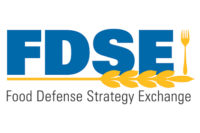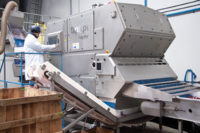Mastering a safe food plant is one thing—maintaining it is another. That’s why companies like Tyco Integrated Security developed a Mobile Security Management system, which includes a remote management application that enables customers to manage security systems from remote locations using any web-enabled  device such as a smartphone, tablet or laptop.
device such as a smartphone, tablet or laptop.
Marina Mayer, editor-in-chief of Refrigerated & Frozen Foods, talked exclusively with Don Hsieh, director of commercial and industrial marketing for Tyco Integrated Security, Boca Raton, Fla., to learn about the difference between food safety and food defense, as discussed at Tyco’s sponsored event, Food Defense Strategy Exchange 2013, which took place April 16-18 in Chicago.
Refrigerated & Frozen Foods: What do you see as being some of the most common challenges refrigerated and frozen food processors face when practicing food safety?
Don Hsieh: Given the nature of refrigerated and frozen foods, obviously temperature controls are key in food safety, both at the plant level and in the supply chain. I do want to take it up a level and talk about one thing that was covered a lot at the conference. It’s really from a food defense perspective as well as food safety, which is our primary focus.
Food supply chains are longer now, like seafood, which is I believe up to 80% imported at this point, so longer supply chains mean that there’s just a lot more vulnerability in that supply chain. The increased vulnerability is clearly evidenced by the number of recalls, which have increased substantially over the last few years, which of course, prompted the Food Safety Modernization Act (FSMA) about two years ago.
The other factor that I think is important for all food manufacturers is the reality that we are living in a social media world, so it’s imperative to put in place preventative controls for both food safety and food defense. Once something happens, it could be very damaging to the brand very quickly, and the time to respond is very short, so I think it’s prudent for the companies in the food space to really implement preventative controls to prevent something like [recalls] from happening, whether it’s a food safety issue or a food defense issue.
There was an international products safety consultant a few years back who said there was a $2 billion impact annually for problems in the supply chain with transportation, which covers everything from cargo theft, tampering and sabotage to temperature and waste in the cold chain.
At the conference, we covered cargo theft in particular, and it’s been three years in a row where food and beverage has been the most frequent of all industries to be targeted for cargo theft, which has been a concerning trend. It used to be high-value products such as electronics but they have implemented more proactive solutions to combat cargo theft, so the criminals appear to have moved to softer targets. Unfortunately, I think food and beverage has bore the brunt of that and has become the industry with the most cargo theft.
R&FF: Why do you think the food and beverage industry experiences the most cargo theft out of other industries?
Hsieh: The law enforcement officials attribute it to a couple of factors.
Electronics and pharmaceutical industries that were hit profusely have implemented more preventive controls in that space, so it becomes a harder target.
Another part is that these law enforcement organizations say that products that are serialized, like electronics, are harder to get value for. [Thieves] may get 30 cents to the dollar for it. For a branded product, like in the food arena where they’re not serialized, they may get 70 cents to the dollar for it. If they get multiple hits on the same food product, they can get as much “profit,” if you will, from a criminal perspective, than from a load of electronics. It may also be due to the tough economy in the past few years, so that may be another reason as well.
R&FF: What role does Tyco Integrated Security play in helping processors achieve and maintain their food safety goals?
Hsieh: In the temperature area, because there are technologies like sensors that monitor temperature, humidity, light and location, we implement services that we call Critical Condition Monitoring. It’s used for a device like refrigeration equipment or reefer trucks, any of those areas where you need to maintain that cold chain. The sensors can be set to monitor below a certain temperature or above a certain temperature. It can trigger an alert, which can then be monitored to provide communications directly to the individuals that need to be alerted, immediately, of any break in the cold chain, so they can take the appropriate actions. That’s one thing that’s specific to the cold chain activity that applies not only to fixed plants and processors but even within the product’s food supply chain.
Beyond the temperature aspect and combating cargo theft, there are a couple areas with respect to access control that can play a part [in helping processors achieve and maintain their food safety goals].
One thing that was discussed at the conference is that it begins with what we call fraudulent pickups. Companies might represent themselves and say, “hey, I’m here to pick up a load of Kraft products,” knowing that the Kraft guy is coming later that day, and so, they might present identification that pretends to be from Kraft Foods. But, we have identity management software that can detect whether it’s a counterfeit driver’s license or not, checking in all 50 states, and can search through criminal databases, so that you can minimize the possibility of a fraudulent pickup.
In terms of the cargo itself, we work with a vendor called MAGTEC, Calgary, Canada, who can not only monitor the route of the truck via GPS to tell if the truck diverges from a specified route, but the solution has the ability to remotely control the truck itself so that it can actually stop the truck safely in 10-mpg increments, so you can alert the authorities and stop the truck at a specific point, so authorities can be there to prevent the load from being stolen. It’s a much more proactive way to protect your product than not knowing until the truck fails to show up, and by that time, especially if you’re a brand owner, product could be adulterated, could have broken the cold chain, could be re-sold into the legitimate supply chain and people get sick and so forth. You have to be proactive with these solutions and prevent that kind of cargo theft from happening and protect the safety of the product until it reaches the consumer.
R&FF: Tyco recently introduced a Mobile Security Management system. Please explain the advantages of this system and how it benefits refrigerated and frozen food processors.
Hsieh: The key benefit to the Mobile Security Management solution is that you’re able to use your mobile devices to both arm and disarm the burglar alarms remotely.
One example that could easily help a manager in a food processing plant is to be able to watch employees after hours coming in who didn’t have the proper access codes to enter the facility. If he calls the manager up and says, “hey, I forgot something. I need to get something done,” and the manager obviously recognizes the individual, he can then disarm the alarm for the employee to come in and fix whatever has to be done, and then re-set the alarm after he leaves.
In terms of the temperature area, it can be set with sensors. For example, a refrigeration unit is out in the middle of the night and it triggers a temperature alert that immediately notifies the manager on their mobile device. Then they can address it immediately as opposed to waiting until the next morning and then find out that everything is spoiled.
R&FF: Outside of refrigerated and frozen foods, are there other food categories that this mobile device would apply to?
Hsieh: A very relevant segment would be the restaurant and foodservice business. You may be a franchise owner who runs maybe five quick-service restaurants, for example, and he can’t be in all five places at the same time. He might want to observe new employees that are being trained in one location while he’s in another. He can basically look at the cameras to observe the food line or the cashier line, make sure people are trained and doing what they’re supposed to do. And of course, the whole arming and disarming of the alarms can be just as relevant. An employee is coming in 30 minutes early, and the alarm is not set to open the doors yet; you could go ahead and disarm the alarm.
A lot of it is the benefit of remotely managing each of his stores if you will.
R&FF: Is there anything else that was discussed at the conference that is key to the food safety sector of the business?
Hsieh: One of the key things is that the FDA demoed a pre-release version of what’s called the Food Defense Plan Builder software. This tool is actually designed to help companies manage and build out a food defense plan. It goes through each of the key areas of vulnerabilities, and depending on the vulnerability, it suggests specific mitigation strategies to protect against that vulnerability, and to build out a plan that addresses each of the vulnerabilities. It’s similar to the HACCP process that most food safety quality managers are familiar with, but then extends that process and looks at it from a food defense perspective.
Instead of identifying vulnerabilities from a food safety perspective, the plan looks at it from a food defense perspective, evaluating mitigation strategies and then monitoring progress against them to see how you’re doing, building out a complete plan. I think this will be a very valuable tool that will be released soon. We were just fortunate to get a pre-released version of it with a very key audience that the FDA wanted to reach, and so we were able to set up the workshop at the conference.
Another very engaging topic that was discussed was the social media perspective. We had a speaker from the UK who is involved with a project in Europe called the Food Risc project, sponsored by the EU. This project was designed to assess the social media impact of a food contamination event. They studied what happened in the past, for example, a dioxin poisoning in Irish beef, and studied what resources consumers used from a social media perspective, how long did those messages stay online and how fast was their response.
The key messages were:
1. In the event of a contamination event, the response on social media probably will happen too fast for you to react to it unless you have a plan ahead of time on how to respond in the event of a crisis.
2. Understand where your consumers are getting their information on your products today, and make sure you are in the same avenues to connect and communicate with your consumers.
3. Create a communication plan, so that in the event of a crisis, you can immediately take action to protect the consumer from the products if there is a safety risk. But if there’s not, you can also get the message out through the communication vehicles that your product is safe and why.
The key point is that you have to have a plan on how to respond in a crisis before it hits because you won’t have time to develop one after it hits because social media won’t offer you the luxury of time.
Take for example the pink slime epidemic. It was within a matter of weeks that social media took off on that topic, and literally, companies were shut down because they weren’t prepared to respond quick enough to communicate their side of the story before they had to close so many plants. That was probably an indication of the lack of pre-planning for the social media world that we live in today. It’s necessary to prepare for these types of crisis ahead of time, and there are tools to analyze that and learn where consumers are engaging, so you can be there and plan for it.



